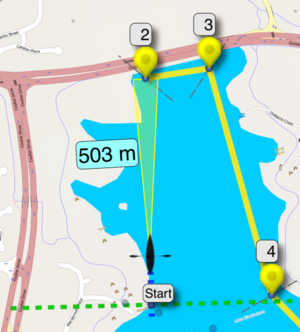Route

A Route is a collection of Waypoints along a path from the Start Line to the Finish Line. The route is shown as a line on the map that the Animated Paddler icon follows.
The Routes Command Button can be used to select a new Route from the ones already loaded into the database.
The Record Command Button can be used to load the Empty_Route.GPX file so that you can start paddling without any planned Route. If you email your paddle statistics, a GPX and a KML file for the route will also be attached. You can share these with others or open them using KayakNav to load them into the Database.
When you use Email Command Button to send your paddling statistics, KayakNav also creates a KML file and attaches this with the results. This allows you to share your route with others or to load a random paddle route that you have previously completed. If you have GoogleEarth installed on your computer, you can also open the KML file to see the route within GoogleEarth.
KayakNav supports multiple routes and will automatically load the nearest route to you, or you can use the Command Buttons to select and load a route. It does this by finding the closest route starting point to your current GPS location.
In order to create a new route you can either:
- Just plot your path on GoogleEarth and email yourself the KMZ or KML file.
- Select the Blank Route and start paddling. The route will be recorded and stored for later use.
If you open a KMZ or KML file, KayakNav be one of the available Apps that is registered to open it. If you select KayakNav to open the file, any KMZ will be unzipped and processed like a KML file. KayakNav processes the XML content of the file into a series of Waypoints. The Route is then optimised by removing intermediate waypoints and the route is stored in an internal database for faster performance. The Route optimisation picks the shortest path to minimise your paddle time. The storage of routes inside the database also allows KayakNav to handle routes of virtually any size. It also calculates all the statistics required to track your paddling.
Next time you select a Route or it is auto-selected for you, it will load quickly from the database.
You may notice that the route you created on GoogleEarth from the start point though to a finish point contains an extra waypoint before the start and after the finish. These Pre-Start Waypoint and Post-Finish Waypoints are automatically generated by KayakNav when the route is optimised. These allow the special Start Line and Finish Lines to be drawn as Bisect Lines through the start and finish waypoints.
The line representing the route on the map is composed of:
- A blue dotted line that marks the completed part of the route.
- A Targeting Beam with distance indicator from the paddler to the next turning point.
- A solid yellow line showing the route for about 2 km.
- A dotted yellow line showing the route beyond 2 km ahead.
The line gets progressively lighter towards the finish. This was required so that routes that involve multiple laps of the same course are still legible and not obscured by the route a long way from the paddler's current location.